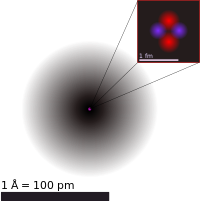
Photo from wikipedia
Inspired by the recently-reported strong electric-dipole (E1) transition between the weakly-bound first and second excited states, 3/2- at 765 keV and 1/2+ at 885 keV, in the nucleus 27Ne, the… Click to show full abstract
Inspired by the recently-reported strong electric-dipole (E1) transition between the weakly-bound first and second excited states, 3/2- at 765 keV and 1/2+ at 885 keV, in the nucleus 27Ne, the E1 transition is estimated in a model by properly taking into account the effect of both deformation and weakly-bound neutrons. In addition to both the spin-parities, 1/2+ and 3/2-, and observed nearly degenerate energies of the two excited states, the observed order of magnitude of the E1 transition strength between the two states is very naturally explained in the case that these two excited states are prolately deformed, in terms of the transitions between the halo components of the wave functions of the weakly-bound odd-neutrons, s1/2 -> p3/2 and s1/2 -> p1/2, in addition to the large probability of the p3/2 component in the weakly-bound neutron [330 1/2] orbit. The large probability is the result of the shell-structure unique in weakly-bound or resonant neutrons.
Journal Title: Physical Review C
Year Published: 2019
Link to full text (if available)
Share on Social Media: Sign Up to like & get
recommendations!